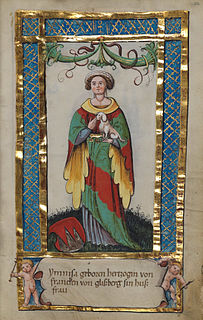Related Research Articles

Rudolf of Rheinfelden was Duke of Swabia from 1057 to 1079. Initially a follower of his brother-in-law, the Salian emperor Henry IV, his election as German anti-king in 1077 marked the outbreak of the Great Saxon Revolt and the first phase of open conflict in the Investiture Controversy between Emperor and Papacy. After a series of armed conflicts, Rudolf succumbed to his injuries after his forces defeated Henry's in the Battle on the Elster.

Welf I was Duke of Bavaria from 1070 to 1077 and from 1096 to his death. He was the first member of the Welf branch of the House of Este. In the genealogy of the Elder House of Welf he is counted as Welf IV.

Alberto Azzo II, Margrave of Milan, and Liguria, Count of Gavello, Padua, Rovigo, Lunigiana, Monselice, and Montagnana, was a powerful nobleman in the Holy Roman Empire. He is considered the founder of Casa d'Este, having been head of the first family to be master of Este, a town of Padua.
Gertrud of Brunswick was Countess of Katlenburg by marriage to Dietrich II, Count of Katlenburg, Margravine of Frisia by marriage to Henry, Margrave of Frisia, and Margravine of Meissen by marriage to margrave Henry I. She served as regent of the County of Katlenburg during the minority of her son Dietrich III of Katlenburg, and as regent of the County of Northeim during the minority of her son Otto III of Northeim. She was also one of the leaders of the insurrections against Emperor Henry IV and his son Henry V.
Conrad I was Duke of Swabia from 983 until 997. His appointment as duke marked the return of Conradine rule over Swabia for the first time since 948.

Gerberga of Saxony was a French queen who ruled as regent of France during the minority of her son Lothair in 954–959. She was a member of the Ottonian dynasty. Her first husband was Gilbert, Duke of Lorraine. Her second husband was Louis IV of France. Contemporary sources describe her as a highly educated, intelligent and forceful political player.

Welf III, the last male member of the Swabian line of the Elder House of Welf, was Duke of Carinthia and Margrave of Verona from 1047 until his death.
Albert Atto I was an Italian nobleman. He was a member of the Obertenghi family. From 1014 onward, he was margrave of Milan and count of Luni, Genoa and Tortona.
Berthold I, better known as Berthold of Rheinfelden, was the Duke of Swabia from 1079 until his death. He was the eldest son of Rudolf of Rheinfelden, duke of Swabia, and German anti-king (r.1077-1079) in opposition to Henry IV of Germany.

Welf II was a Swabian count and a member of the Elder House of Welf.
Werner V was a Rhenish Franconian count in the Nahegau, Speyergau and Wormsgau. He is one of the earliest documented ancestors of the Salian dynasty that provided German kings and emperors of the Holy Roman Empire from 1024 to 1125.
Henry the Fat, also known as Henry of Nordheim or Northeim, was Count in Rittigau and Eichsfeld from 1083 onwards, and was the Margrave of Frisia until he was murdered in 1101. He was the father of Empress Richenza.

Kunigunde of Altdorf was a member of the Swabian line of the Elder House of Welf. She was also the ancestress of the younger House of Guelph, a cadet branch of the House of Este.

Imiza of Luxembourg, was a German noblewoman. She was the daughter of Frederick of Luxembourg, and the wife of Welf II of Swabia.
Richlind of Altdorf was a German noblewoman and a member of the Swabian line of the Elder House of Welf.
Ethelinde of Northeim was the daughter of Otto of Northeim and the wife of Welf I, Duke of Bavaria, and Herman of Calvelage.
Matilda of Swabia, a member of the Salian dynasty, was the daughter of Emperor Henry III from his second marriage with Agnes of Poitou. By her marriage to Rudolf of Rheinfelden, she was Duchess of Swabia from 1059-1060, before her early death.

Siegfried I of Ballenstedt, was the son of Adalbert II of Ballenstedt, and a member of the House of Ascania. He was count palatine of the Rhineland (r.1095/7-1113), and count of Weimar-Orlamünde (r.1112-1113).
Adelaide of Ballenstedt was the daughter of Otto of Ballenstedt and a member of the House of Ascania. She married, successively, Henry IV, Count of Stade, and Werner, Count of Osterburg.
Gerberga of Mâcon was, by her successive marriages, queen of Italy (950-963), margravine of Ivrea (965-970), and duchess of Burgundy (971/5-986/91).
References
- A. Thiele, Erzählende genealogische Stammtafeln zur europäischen Geschichte, Band I, Teilband 1 (Frankfurt am Main, 1993).
- D. Schwennicke, Europäische Stammtafeln Neue Folge, Volume I. 1
- B. Schneidmüller, Die Welfen. Herrschaft und Erinnerung (819–1252). (Stuttgart, 2000)
- Freed, John B. (2016). Frederick Barbarossa: The Prince and the Myth. Yale University Press.CS1 maint: ref=harv (link)